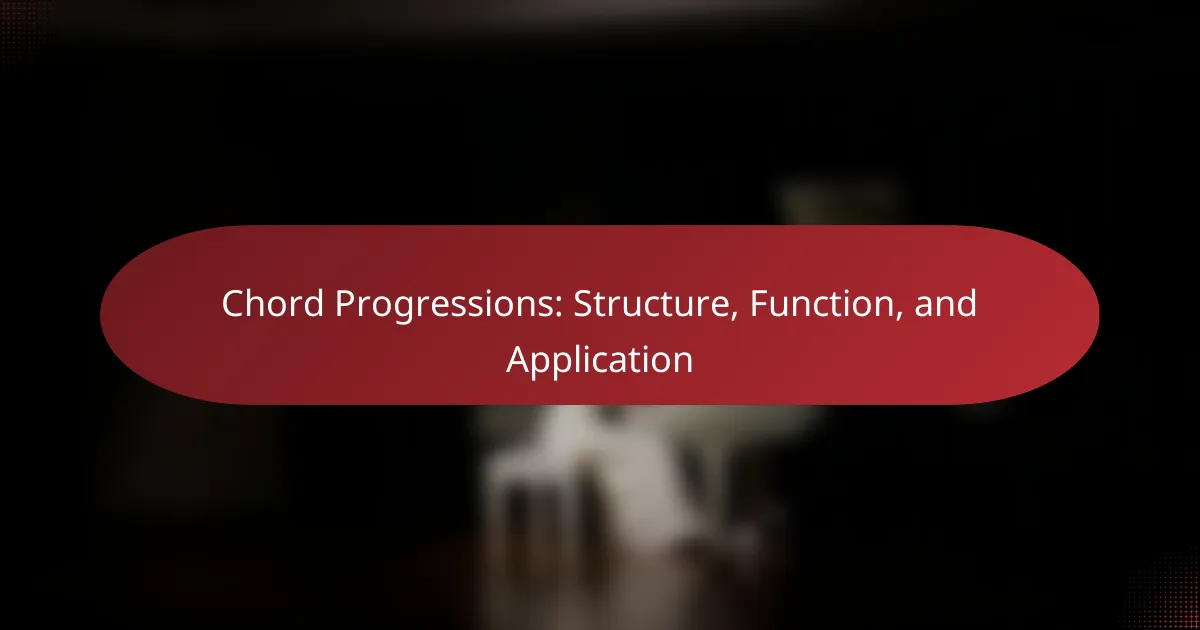Chord progressions are fundamental to music, acting as the structural backbone that shapes melodies and influences the emotional landscape of a piece. By mastering various chord sequences, songwriters can craft compelling harmonic frameworks that resonate with listeners and evoke a wide range of feelings and styles.

How do chord progressions function in music?
Chord progressions serve as the backbone of music, providing structure and direction. They establish the harmonic framework that guides melodies and influences the overall feel of a piece.
Establishing tonality
Chord progressions establish tonality by defining the key of a piece, which determines the set of notes and chords that will be used. For instance, a progression in C major typically revolves around the chords C, F, and G, creating a sense of resolution and familiarity.
Musicians often use common progressions, like the I-IV-V-I sequence, to reinforce the tonal center. This helps listeners identify the key and feel grounded in the music.
Creating emotional impact
Chord progressions can evoke a wide range of emotions, influencing how a piece is perceived. For example, a minor key progression might create a sense of sadness or tension, while major key progressions often convey joy or resolution.
Using techniques such as modulation or unexpected chord changes can heighten emotional responses. For example, transitioning from a minor chord to a major chord can provide a surprising lift, enhancing the overall emotional journey of the music.
Facilitating transitions
Chord progressions facilitate transitions between different sections of a song, helping to maintain flow and coherence. Smooth transitions can be achieved by using pivot chords that are common to both sections, easing the listener from one part to another.
For instance, if a song shifts from a verse in C major to a chorus in A minor, using an E minor chord as a bridge can create a seamless connection. This technique keeps the audience engaged and enhances the overall listening experience.
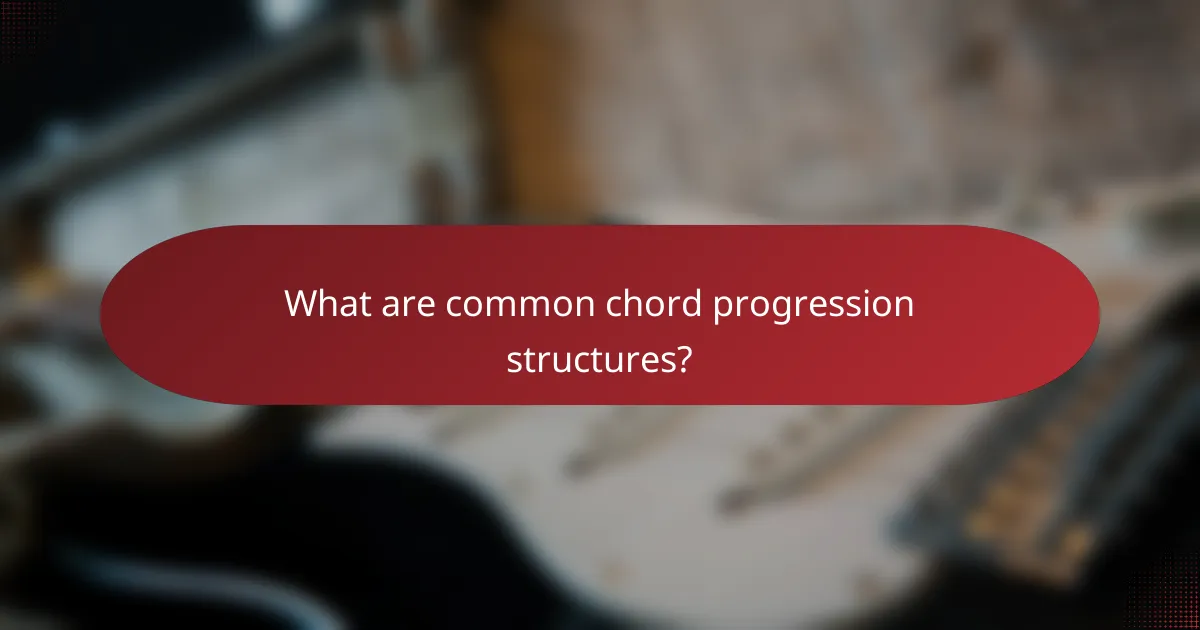
What are common chord progression structures?
Common chord progression structures are sequences of chords that create a harmonic foundation for music. These structures serve as the backbone for melodies and can evoke different emotions and styles.
I-IV-V progression
The I-IV-V progression is one of the most popular chord sequences in Western music, often found in rock, pop, and blues genres. It consists of the first (I), fourth (IV), and fifth (V) chords of a key, creating a strong sense of resolution and movement.
For example, in the key of C major, the chords would be C (I), F (IV), and G (V). This progression is effective for creating catchy and memorable songs, as it allows for easy transitions and a familiar sound.
ii-V-I progression
The ii-V-I progression is a staple in jazz music, known for its smooth transitions and rich harmonic texture. It consists of the second (ii), fifth (V), and first (I) chords of a key, often leading to a satisfying resolution.
In the key of C major, the chords would be Dm (ii), G (V), and C (I). This progression is frequently used in jazz standards and provides a framework for improvisation, making it essential for jazz musicians to master.
I-vi-ii-V progression
The I-vi-ii-V progression is a versatile sequence that combines major and minor chords, creating a dynamic sound. It consists of the first (I), sixth (vi), second (ii), and fifth (V) chords of a key, often used in various genres, including pop and R&B.
In the key of C major, the chords would be C (I), Am (vi), Dm (ii), and G (V). This progression is effective for building tension and can lead to a powerful resolution, making it a favorite among songwriters.
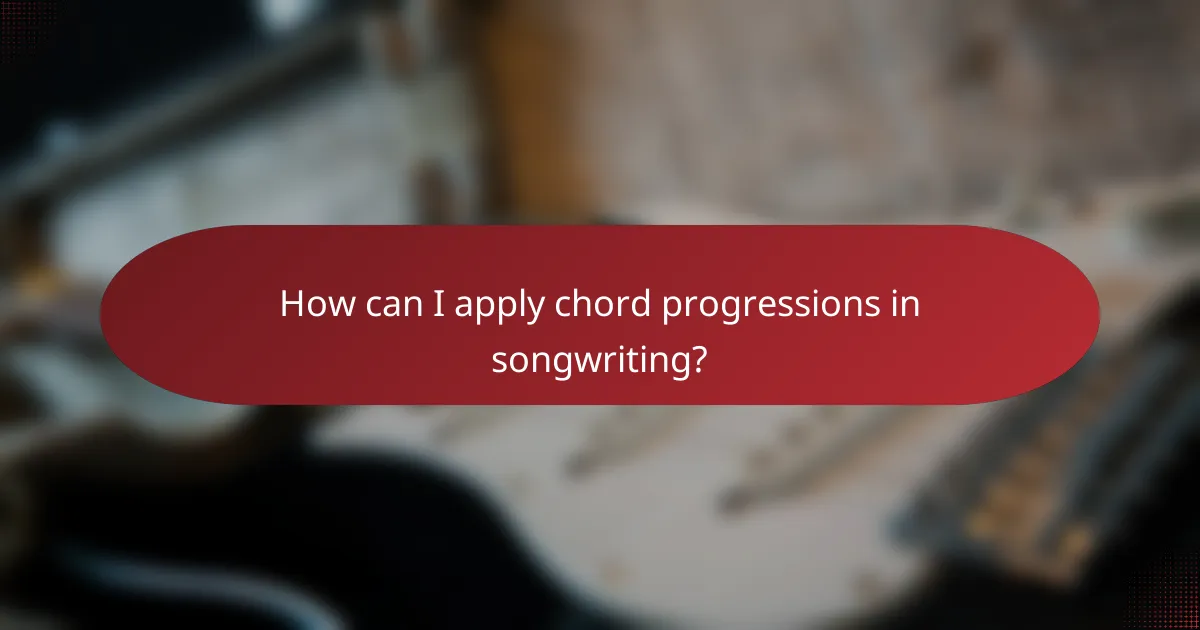
How can I apply chord progressions in songwriting?
Chord progressions are essential in songwriting as they establish the harmonic structure and emotional tone of a piece. By understanding how to effectively apply them, you can create compelling music that resonates with listeners.
Building a song’s foundation
Chord progressions serve as the backbone of a song, providing a framework for melody and lyrics. A common approach is to start with simple progressions, such as I-IV-V or ii-V-I, which are widely used in various genres. These foundational chords help set the mood and guide the listener through the song.
Consider using a progression that matches the emotional intent of your lyrics. For instance, a progression in a major key often conveys happiness, while minor keys can evoke sadness or tension. Experimenting with different keys can also yield unique results.
Enhancing melody
Effective chord progressions can significantly enhance a melody by providing harmonic support and contrast. When crafting a melody, choose chords that complement the notes you are using, ensuring they create a cohesive sound. For example, if your melody emphasizes the tonic note, using the I chord will reinforce that feeling of resolution.
Additionally, consider the rhythm of your chord changes. Syncopated or off-beat changes can add interest and drive to your melody, making it more engaging. Listening to how different progressions interact with your melody can lead to surprising and delightful results.
Creating variations
To keep your songwriting fresh, explore variations in your chord progressions. This can involve changing the order of chords, substituting chords with similar functions, or adding extensions like seventh or ninth chords. These variations can add depth and complexity to your music.
Another technique is to modulate to a different key during a bridge or chorus, which can create a sense of movement and excitement. Be mindful, however, of how these changes affect the overall flow of the song; transitions should feel natural to maintain listener engagement.

What tools can help with chord progression creation?
Several tools can assist musicians in creating chord progressions, each offering unique features and functionalities. These tools range from online platforms to software applications, making it easier to experiment with different chords and structures.
ChordChord
ChordChord is an intuitive online tool designed for generating chord progressions quickly. Users can select a key and a style, and the platform will produce a variety of chord sequences that fit those parameters. This is particularly useful for beginners looking for inspiration or for experienced musicians wanting to explore new ideas.
One of the key features of ChordChord is its ability to allow users to customize the generated progressions. You can adjust the tempo, add melodies, and even export your progressions for use in digital audio workstations (DAWs). This flexibility makes it a valuable resource for songwriters and producers alike.
Hooktheory
Hooktheory offers a comprehensive suite of tools for music composition, including a chord progression creator that emphasizes popular music theory. The platform allows users to visualize chord progressions and understand their function within a song context. This educational aspect can be beneficial for those looking to deepen their understanding of music theory.
With Hooktheory, users can analyze existing songs to see how they are structured, which can inform their own compositions. The tool also provides a library of chord progressions from popular songs, allowing users to experiment with similar structures in their own work.
BandLab
BandLab is a free online music creation platform that includes a built-in chord progression tool. It allows users to create, edit, and collaborate on music projects in real-time. BandLab’s user-friendly interface makes it accessible for musicians of all skill levels, from beginners to seasoned professionals.
In addition to chord progression creation, BandLab offers features like virtual instruments, audio recording, and mixing capabilities. This all-in-one approach enables users to develop their ideas from initial chords to a fully produced track, making it a versatile choice for music creators.
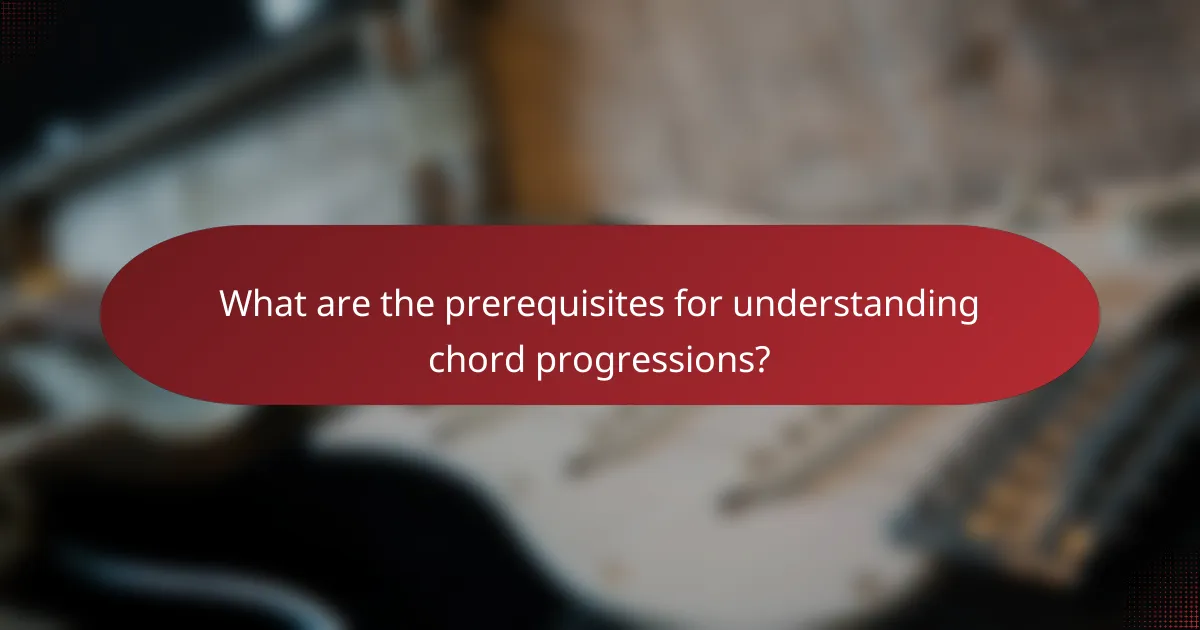
What are the prerequisites for understanding chord progressions?
To understand chord progressions, a foundational grasp of music theory and familiarity with musical scales is essential. These elements provide the framework for recognizing how chords interact and create musical movement.
Basic music theory knowledge
Basic music theory knowledge includes understanding concepts such as notes, intervals, and the structure of chords. Familiarity with major and minor triads, as well as seventh chords, is crucial for analyzing progressions.
Additionally, knowing how to read sheet music and understanding the circle of fifths can greatly enhance your ability to predict and create effective chord progressions. This knowledge allows musicians to navigate through different keys and understand harmonic relationships.
Familiarity with scales
Familiarity with scales is vital for recognizing which chords naturally occur within a given key. Major and minor scales form the basis for most chord progressions, and knowing these scales helps in identifying the tonic, subdominant, and dominant chords.
Practicing scales can also improve your ear for music, making it easier to hear and create smooth transitions between chords. A good rule of thumb is to practice common scale patterns and their corresponding chords to build a solid foundation for composing progressions.
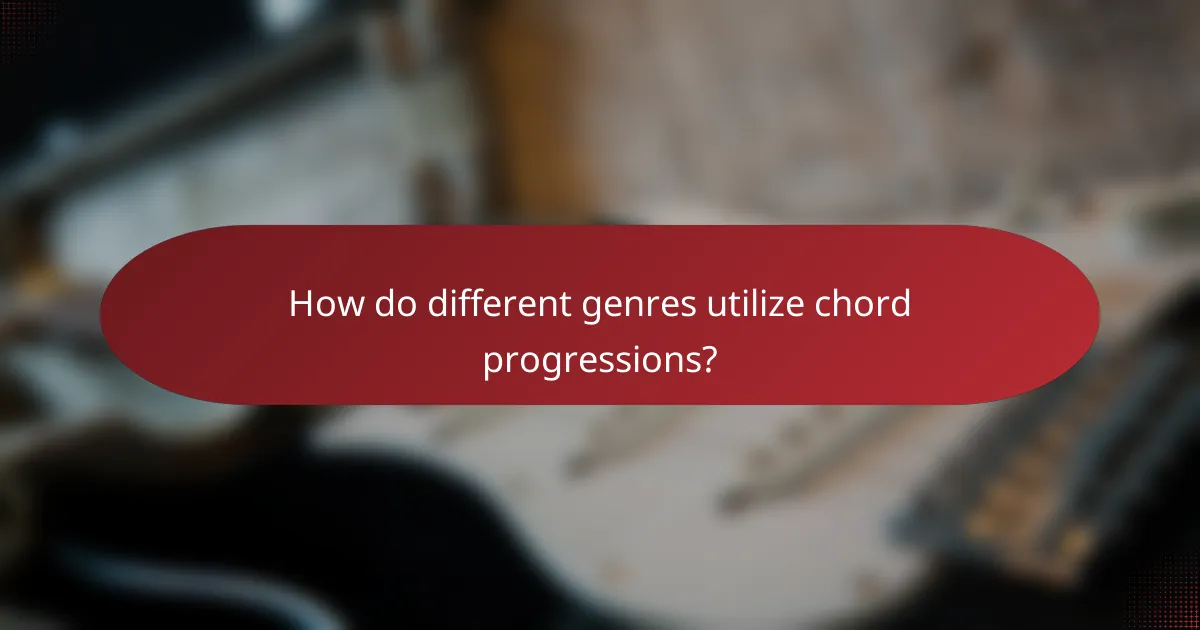
How do different genres utilize chord progressions?
Different music genres employ chord progressions in unique ways to create distinct sounds and emotional impacts. Each genre has typical progressions that resonate with its style, influencing melody and harmony.
Pop music examples
Pop music often relies on simple, catchy chord progressions that are easy to remember. Common progressions include the I-IV-V and I-V-vi-IV sequences, which create a sense of familiarity and appeal. For instance, songs like “Let It Be” by The Beatles and “Someone Like You” by Adele utilize these structures effectively.
In pop, the use of major and minor chords can evoke different emotions, with major chords typically conveying happiness and minor chords expressing sadness. This emotional manipulation is crucial for engaging listeners and enhancing the song’s message.
When writing pop music, aim for progressions that are not overly complex. Sticking to four chords or fewer can help maintain listener interest and make the song more accessible. Experimenting with variations of these common progressions can also yield fresh results while staying within the genre’s framework.






